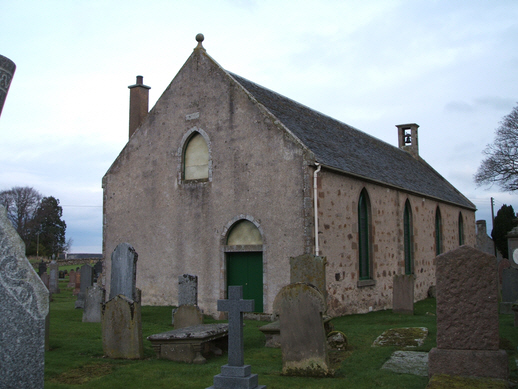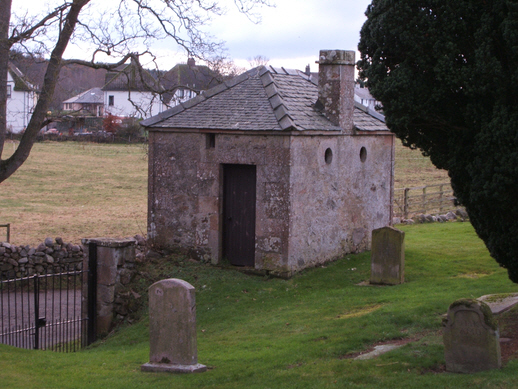Inverness Deanery
Croy
Parish Church: OS Ref: NGR NH 786499 H.E.S. No: NH74NE 78 Dedication: St Duthac of Tain.1
Associated Chapels: Kilravock {NGR NH 814493}.
This parish, which is sometimes found referred to as Croyn, has left only a very faint footprint in the historical record. The location of the ancient, pre-Reformation, church is described as being "lost". The present building was erected in 1764.
Alasdair Ross observes that, "… it looks as if Croy was originally a very small parish of perhaps only three dabhaichean in extent."2 Later in his thesis, in the maps he has drawn,3 he identifies only two dabhaichean that may have comprised the parish of Croy - those of Easter Kilravock (Tomluncart and Knockanbuie; both of ½ dabhach; Tomnacroich; Mossend; Lochend; Poldauuach) and Wester Kilravock. However, these properties in Easter Kilravock, which are still marked on maps (Tomluncart {NGR NH 843526}; Knockanbuie {NGR NH 842522}; Lochend {NGR NH 846531}), are very close together and it is difficult to imagine that they comprised all of Easter Kilravock.
If any proof was needed of the antiquity of the community around Croy one would only need to consider the details of the Croy Hoard found in an area centred at {NGR NH 7950 4936}. One part was found by a girl who was planting potatoes in the spring of 1875 and consists of a Pictish silver penannular brooch (c.820AD); part of a band made of knitted silver wire; a silver penny of Coenwulf, King of Mercia (AD769-821), made by the moneyer Eanmund; two glass and two amber beads and part of a bronze balance beam, which may possibly be dated to the 8th century. At least one other coin and a number of beads were found but these were lost by the finder. A second part of the hoard was found near the of Mains of Croy in 1875 or 1876. It consisted of one, and almost a half of another, silver penannular brooch; one amber and two glass beads; and a coin of Aethelwulf, King of Wessex (AD839-858), made by the moneyer Deineah.4 Near to the find site stands the extraordinary Clach na Sanais ('stone of warning' or 'whisper' or 'secret'). Traditionally, this stone was where a member of Clan Cumming warned the MacIntoshes of the Cummings' plan to massacre them when the MacIntoshes were to be feasted at the Cummings' Castle of Rait {NGR NH 894525}. Forewarned, the MacIntoshes accepted the hospitality but then massacred the Cummings - except, of course, the informer!
However, the matter of the medieval church of Croy has no ready solution. The evidence noted below would lead us to believe that there was a church somewhere in the parish at least as early as 1226 and possibly as far back as 1145 or further. Although a prebend was created from the 'parsonages' of Croy and Lunyn, the two churches were not united as a result of this. Indeed, Lunyn (Moy) {NGR NH 772342} is situated at some distance from Croy. We must remember Ross' comments (see above) that Croy was a very small parish and this seems to be borne out by the evidence. Much of the land hereabout was part of Dalcross parish and even Easter Kilravock is noted as being part of Dalcross in one source.5 In summary - the lands of Croy and the advowson of 'the church' are claimed to have been in the hands of the de Moravia family since c.1150; the parish of Croy existed c.1236; it was very small; the parsonage tithes of Croy (with those of Moy) formed the prebend of a canonry (the Bishop's Vicar) in Elgin Cathedral having his own residence within the Chanonry; the location of the medieval church is unknown.


Above: The parish church of Croy and the "Watch-house" in the graveyard.
Kilravock: There is a strong tradition of a chapel having stood close to Kilravock Castle where now there are the ruins of an old dovecote. The chapel's existence is certain, as we can see from the records of an 'Inquisitio' held in 1343 to settle a dispute between the Laird of Kilravock, Hugh de Ros, and the then Prior of Urquhard, William Buttyrgask.6 Urquhard Priory held property in Kilravock to the value of £24, namely - a brew-house or malt-house; pasturage for 30 animals with their young; 80 sheep; two horses; forest rights, etc. The Vicar of Dalcross,7 was to be required to celebrate mass twice per week at the chapel at Kilravock and the Prior agreed to provide all that was necessary to allow him to perform these services. The family of Kilravock first established themselves on the estate of Geddes, a little distance to the east and close to the castle and lands of Raite. Here, there was theChapel of Raite dedicated to St Mary {NGR NH 888529} and this chapel, now a ruin, was the ancestral burial place of the Kilravock family for many generations.
1226 (9 October) W. de M (Walter de Moravia) says that he and his family have had the lands of Croy(n) for the past 80 years, along with the advowson of the church. Walter quitclaims the lands of Croyn to the bishop.8
1226 Bishop Andrew 'constitutit' the prebend of Croyn & Lunyn in the cathedral at Elgin and stipulated that the canon holding the prebend was to act as the bishop's vicar - deputizing for the Bishop when required. 9
In 1618, the two parishes of Croy and Dalcross were united.10
Clergy:
1232 Archibald, canon of Croy. [Reg. Ep. Mor., no.68, p.72]
1237 Archibald, canon of Croy. [History of Pluscarden, p.206]
1242 William de Rift', canon of Croy. [Reg. Ep. Mor., no.93, p.107]
1415 Andrew de Munro, canon of Croy. (see below and 1430 - Andrew de Munro)
1415 John de Inchmartin, canon of Croy. (see 1430 below - Andrew de Munro)
1422 Edward Lawder, canon of Croy. He was provided to the canonry of Croy (6 March) after supplicating the Pope. [Inchcolm Charters, p.172] Although he had provision he never seems to have had possession of this canonry. He offres to resign any right he has in it if the Pope provides him to the canonry of Glasgow Primo, in Glasgow cathedral. (He was already archdeacon of Lothian, St Andrews Diocese. He was one of the most prolific holders of multiple benefices (plurality) of his era.)
1423 Thomas de Greenlaw, is said to have resigned the canonry of Croy in this year. [CSSR, ii, p.43]
1423 John Derling, MA, Lic.Theol., already a canon of Brechin and Dunkeld cathedrals, is provided to the canonry of Croy by the Pope to replace Thomas de Greenlaw. [CSSR,ii, p.43]
1424 John Derling, received a further provision to the canonry of Croy by the Pope (17 April 1424) since his previous letters of provision were defective. [CSSR, ii, p.65]
1424 Gilbert Forester, supplicates the Pope for provision to the canonry of Croy (void by the resignation of Thomas de Greenlaw), notwithstanding that he holds the perpetual vicarage of Enerlethane {Innerleithen, Glasgow Dioc.} and the Poors' Hospital of St Mary Magdalene outwith the walls of Perth, and the right he claims in the church of Haddington, St Andrews Diocese. [CSSR, ii, p.76]
1428 John Darling, canon of Croy, had died at the Curia by this date (29 February 1428). [CSSR, ii, p.190]
1428 Thomas de Tulloch, claims that even though Thomas de Greenlaw supposedly resigned this canonry, he still is occupying it. Thomas supplicates that the Pope would provide him to the canonry of Croy, notwithstanding that he currenlty holds the archdeaconry of Caithness (i.e. to hold both benefices together). [CSSR, ii, p.190] Again, in 1429, he makes supplication to the Pope stating that, "although the archdeaconry is a solemn and onerous dignity (solemnis et onerosa), yet its fruits, owing to sinister conditions of the times, are not a little diminished so that he cannot fittingly be sustained and support burdens incumbent upon him". He asks to be allowed another benefice, in addition to the archdeaconry and the canonry of Croy which is the subject of litigation in the Curia. His request is granted on 7 June 1429. [CSSR, iii, p.23] But the situation is still on-going in 1430 when Thomas de Greenlaw is continuing to assert his rights of possession of Croy. [CSSR, iii, p.119]
1430 Andrew de Munro, archdeacon of Ross. Exchanged the canonry of Croy sometime c.1415 with John de Inchmartyn for the archdeaconry of Ross. Although 15 years have passed, the validity of this exchange is dow doubted and Andrew supplicates that the Pope should confirm the arrangement, notwithstanding that he had received a dispensation for 'defect of birth' (bastardy) being the son of a priest and an unmarried woman. Pope grants the request 29 December 1430. [CSSR, iii, p.156]
1. Scottish Archive Network, National Records of Scotland. catalogue.nrscotland.gov.uk accessed 20/6/2019.
2. Ross, A. (2003) The Province of Moray, c.1000-1230. Unpublished PhD thesis, University of Aberdeen. Vol.1, p.77.
3. Ross, A. (2003) The Province of Moray, c.1000-1230. Unpublished PhD thesis, University of Aberdeen. Vol.2, p.62.
4. Highland Historical Environment Record MHG2903 https://her.highland.gov.uk/Monument/MHG2903 accessed 25/6/2019 (A photograph of the Hoard is shown on this page.) The Croy Hoard is now housed in the National Museums of Scotland in Edinburgh.
5. Macphail, S.R. (1881) History of the Religious House of Pluscardyn. Glasgow: Dunn & Wright. p.256
6. Rose, H., Shaw, L., Innes, C. (ed.) (1848) The Family of Rose of Kilravock. Edinburgh: Spalding Club. p.117-8. Dated the first Wednesday after the Feast of St Andrew, (3 December), 1343.
7. The church of Dalcross had been annexed to Urquhard Priory before this date. The Priory possessed similar holdings within the estate of Geddes which, of course, is the most ancient seat of the family of Rose.
8. Registrum Episcopatus Moraviensis, no.31, p.23
9. ibid., no.68, p.72
10. 3rd Statistical Account of Scotland.
e-mail: admin@cushnieent.com
© 2019 Cushnie Enterprises
